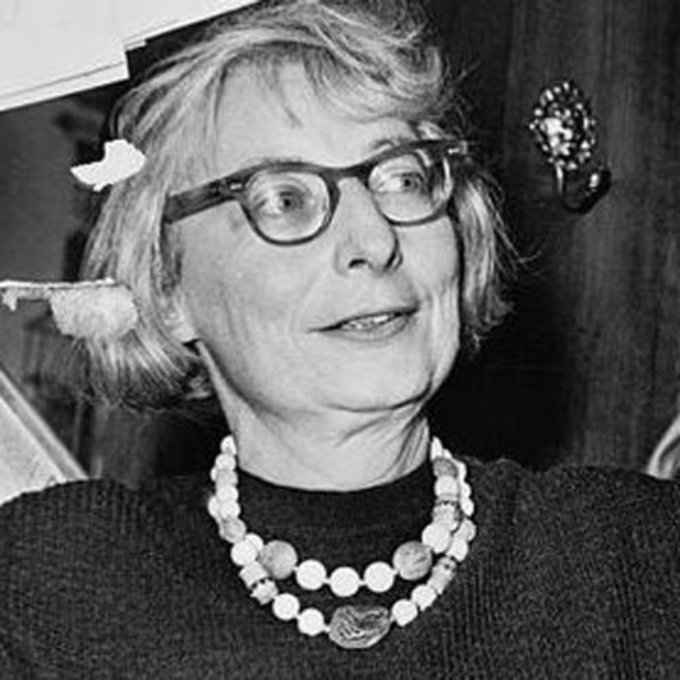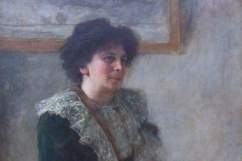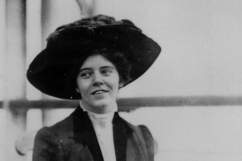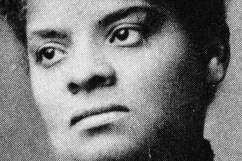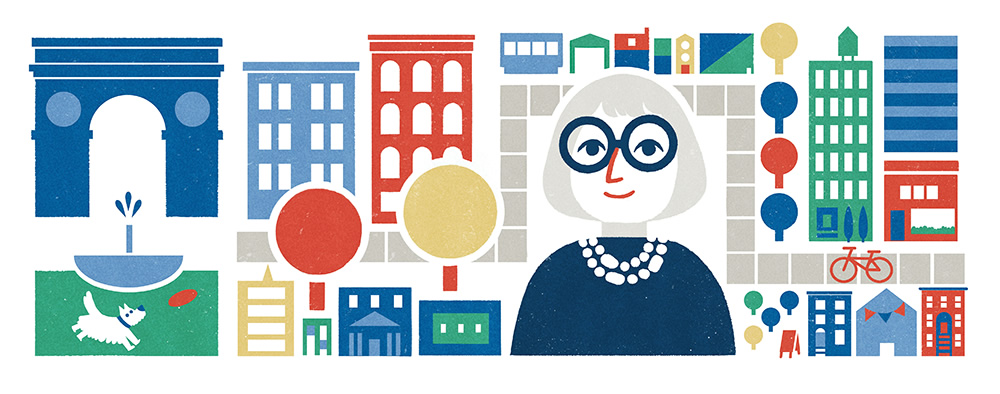
Jane Jacobs. (Google Doodle)
Journalist, author and activist Jane Jacobs is being celebrated May 3, 2016, with a Google Doodle on what would have been her 100th birthday.
Jacobs, who died in 2006, is best known for her work in urban planning, including her book, The Death and Life of Great American Cities.
“Both by her writing and her activism, Jacobs promoted livable cities—walkable, enjoyable, sociable places where communities provide distinctive experiences and locals have a say in determining what goes on,” Sharon Zukin, a professor of sociology at Brooklyn College and the City University of New York Graduate Center, writes on the Oxford University Press’s blog. “But her life—for at that time, she was a feisty New Yorker—provides a complementary text about the virtues of fighting the machine. With fellow community activists in Greenwich Village, Jacobs successfully challenged plans of the city’s urban renewal bureaucracy that would tear neighborhoods apart by building highways and massive public housing projects.”
She became a leading voice in the world of urban design, despite her lack of a college degree and any formal education in the field.
Here’s what you need to know about Jacobs:
1. She Was Born in Pennsylvania & Began Working in Journalism After Graduating From High School
Jane Jacobs was born Jane Butzner in Scranton, Pennsylvania, on May 4, 1916. Her father, John Butzner, was a doctor, and her mother, Bess Robison Butzner, was a teacher and nurse, according to her New York Times obituary. Her brother, John Decker Butzner Jr., was a federal judge.
After graduating from Scranton High School, she worked as an assistant to the women’s page editor at the Scranton Tribune. She then moved to New York City with her sister, living first in Brooklyn and then in Greenwich Village. She worked as an editor and writer, including selling articles to the Sunday Herald Tribune and Vogue.
She studied for two years at Columbia University, but did not graduate. Jacobs then worked for Amerika, a U.S. State Department publication, until it moved its offices to Washington D.C. in 1952.
2. As a Married Mother of 3, She Had to Face Down Claims of Being a ‘Militant Dame’ & ‘Housewife’
Jane Jacobs met her husband, architect Robert Jacobs, in 1944 while working for the State Department, according to her obituary in the Washington Post.
Jacobs began working as an editor for Architectural Forum as an editor after leaving the State Department. While there she began developing an interesting in urban development and planning.
As a woman, wife and mother, Jacobs often had to fend off sexist attacks. She was called a “militant dame” and dismissed as a “housewife” by her opponents.
She and her husband had three children, sons James and Ned, and a daughter, Burgin.
3. She Had a Rivalry With Prominent City Planner Robert Moses
Jane Jacobs had a rivalry with leading New York city planner Robert Moses, who was known as the “Master Builder,” led development in New York City, Long Island, Rockland County and Westchester County, between the 1930s and 1970s.
Moses, “built 13 bridges, 416 miles of parkways, 658 playgrounds, and 150,000 housing units, spending $150 billion in today’s dollars. If you are riding the waves at Jones Beach or watching the Mets at Shea Stadium or listening to ‘La Traviata’ at Lincoln Center or using the Triborough Bridge to get to the airport, then you are in the New York that Moses built,” according to the New York Sun.
Jacobs often spoke out publicly in opposition of Moses’ plans. She disapproved of planners like Moses.
“The planner’s greatest shortcoming, I think, is lack of intellectual curiosity about how cities work,” she told Reason in 1989. “They are taught to see the intricacy of cities as mere disorder. Since most of them believe what they have been taught, they do not inquire about the processes that lie behind the intricacy. I doubt that knowledgeable city planning will come out of the present profession. It is more likely to arise as an offshoot of economics.”
You can read some of Jacobs’ key ideas from Janes Walk, an organization set up to promote her works and honor her legacy.
“Jacobs saw cities as ecosystems that had their own logic and dynamism which would change over time according to how they were used. With a keen eye for detail, she wrote eloquently about sidewalks, parks, retail design and self-organization. She promoted higher density in cities, short blocks, local economies and mixed uses,” Jane’s Walk writes.
She wrote in The Death and Life of Great American Cities:
Under the seeming disorder of the old city, wherever the old city is working successfully, is a marvelous order for maintaining the safety of the streets and the freedom of the city. It is a complex order. Its essence is intricacy of sidewalk use, bringing with it a constant succession of eyes. This order is all composed of movement and change, and although it is life, not art, we may fancifully call it the art form of the city and liken it to the dance — not to a simple-minded precision dance with everyone kicking up at the same time, twirling in unison and bowing off en masse, but to an intricate ballet in which the individual dancers and ensembles all have distinctive parts which miraculously reinforce each other and compose an orderly whole. The ballet of the good city sidewalk never repeats itself from place to place, and in any one place is always replete with new improvisations.
4. She Was Arrested During Her Fight to Stop the Lower Manhattan Expressway
One of Jane Jacobs’ biggest fights came when Robert Moses and others began planning the Lower Manhattan Expressway through her home of Greenwich Village.
Also known as LOMEX, the controversial proposal was designed by Moses in 1941, but was delayed until 1961, according to Untapped Cities:
It would connect the Manhattan and Williamsburg Bridges to the Holland Tunnel. It would have also cut through SoHo and Little Italy, and the plan was ultimately nixed in 1962 due to widespread disapproval from the public (and from Jane Jacobs, of course). …
The project would raze fourteen blocks of what is currently SoHo and Little Italy and cost the city an estimated $72 million in total, including the displacement of just under 2,000 families and over 800 businesses.
During her fight against LOMEX, Jacobs found herself in jail, according to the Washington Post. She was arrested at a public meeting on charges of second-degree riot and criminal mischief. Police said she and others rushed the stage to tear up the stenographer’s transcript tape of the meeting.
The charges were reduced to disorderly conduct and she paid for a new stenographer’s machine, the Post said in her obituary.
Jacobs was also arrested while protesting the draft during the Vietnam War and waged many fights against the government.
“I hate the government for making my life absurd,” she told the journal Government Technology in 1998, according to the New York Times.
5. She Moved to Toronto in 1968 & Lived There Until Her Death
Jane Jacobs moved to Toronto in 1968 and is also influential in how that city, and others in Canada, including Vancouver, were planned.
According to the New York Times, she moved shortly after her arrest and out of opposition to the Vietnam War. Her sons were of draft age.
She died on April 25, 2006, at the age of 89, after suffering a stroke. She was survived by her two sons and daughter, two grandchildren and two great-grandchildren.
“What’s important is not that she died but that she lived, and that her life’s work has greatly influenced the way we think,” her family said in a statement. “Please remember her by reading her books and implementing her ideas.”
An exhibit, “Jane at Home,” is currently on display at Toronto’s Urbanspace Gallery, featuring items from her life. It was curated by her son, Jim Jacobs, and architect Maggie Zeidler.
“We’re pack rats — we don’t throw anything away,” Jim Jacobs told the National Post. “All of that will give a picture of how she worked. It’s an exhibit with a hundred stories.
Other celebrations of Jacobs’ 100th birthday are expected to be held, including Jane’s Walk, “a movement of free, citizen-led walking tours inspired by Jane Jacobs. The walks get people to tell stories about their communities, explore their cities, and connect with neighbours.”
You can find upcoming Jane’s Walks here.
